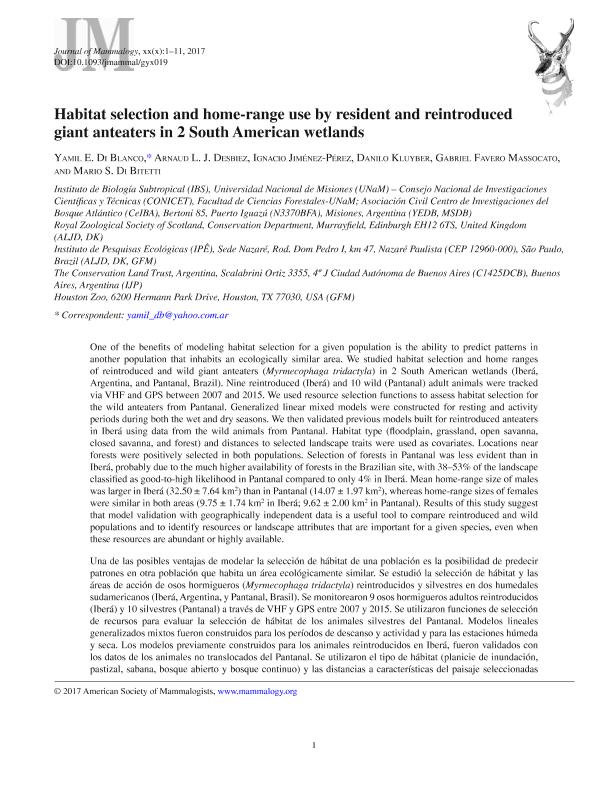Artículo
Habitat selection and home range use by resident and reintroduced giant anteaters in two South American wetlands
Di Blanco, Yamil Edgardo ; Desbiez, Arnaud L. J.; Jiménez Pérez, Ignacio; Kluyber, Danilo; Favero Massocato, Gabriel; Di Bitetti, Mario Santiago
; Desbiez, Arnaud L. J.; Jiménez Pérez, Ignacio; Kluyber, Danilo; Favero Massocato, Gabriel; Di Bitetti, Mario Santiago
 ; Desbiez, Arnaud L. J.; Jiménez Pérez, Ignacio; Kluyber, Danilo; Favero Massocato, Gabriel; Di Bitetti, Mario Santiago
; Desbiez, Arnaud L. J.; Jiménez Pérez, Ignacio; Kluyber, Danilo; Favero Massocato, Gabriel; Di Bitetti, Mario Santiago
Fecha de publicación:
02/2017
Editorial:
Oxford University Press
Revista:
Journal of Mammalogy
ISSN:
0022-2372
Idioma:
Inglés
Tipo de recurso:
Artículo publicado
Clasificación temática:
Resumen
One of the benefits of modeling habitat selection for a given population is the ability to predict patterns in another population that inhabits an ecologically similar area. We studied habitat selection and home ranges of reintroduced and wild giant anteaters (Myrmecophaga tridactyla) in 2 South American wetlands (Iberá, Argentina, and Pantanal, Brazil). Nine reintroduced (Iberá) and 10 wild (Pantanal) adult animals were tracked via VHF and GPS between 2007 and 2015. We used resource selection functions to assess habitat selection for the wild anteaters from Pantanal. Generalized lineal mixed models were constructed for resting and activity periods during both the wet and dry seasons. We then validated previous models built for reintroduced anteaters in Iberá using data from the wild animals from Pantanal. Habitat type (floodplain, grassland, open savanna, closed savanna, and forest) and distances to selected landscape traits were used as covariates. Locations near forests were positively selected in both populations. Selection of forests in Pantanal was less evident than in Iberá, probably due to the much higher availability of forests in the Brazilian site, with 38?53% of the landscape classified as good-to-high likelihood in Pantanal compared to only 4% in Iberá. Mean home range size of males was larger in Iberá (32.50 ± 7.64 km2) than in Pantanal (14.07 ± 1.97 km2), whereas home range sizes of females were similar in both areas (9.75 ± 1.74 km2 in Iberá; 9.62 ± 2.00 km2 in Pantanal). Results of this study suggest that model validation with geographically independent data is a useful tool to compare reintroduced and wild populations and to identify resources or landscape attributes that are important for a given species, even when these resources are abundant or highly available.
Archivos asociados
Licencia
Identificadores
Colecciones
Articulos(CCT - NORDESTE)
Articulos de CTRO.CIENTIFICO TECNOL.CONICET - NORDESTE
Articulos de CTRO.CIENTIFICO TECNOL.CONICET - NORDESTE
Articulos(IBS)
Articulos de INSTITUTO DE BIOLOGIA SUBTROPICAL
Articulos de INSTITUTO DE BIOLOGIA SUBTROPICAL
Citación
Di Blanco, Yamil Edgardo; Desbiez, Arnaud L. J.; Jiménez Pérez, Ignacio; Kluyber, Danilo; Favero Massocato, Gabriel; et al.; Habitat selection and home range use by resident and reintroduced giant anteaters in two South American wetlands; Oxford University Press; Journal of Mammalogy; 98; 4; 2-2017; 1118–1128
Compartir
Altmétricas



